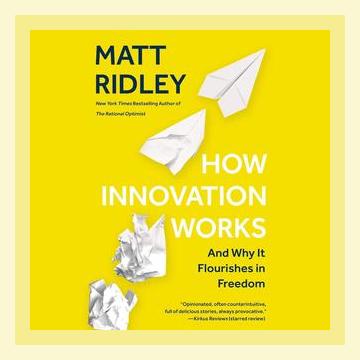Leadership and ManagementInnovation Leadership
Title: How Innovation Works: And Why It Flourishes in Freedom
Author: Matt Ridley
Published: 2020
Categories: Innovation, Leadership
1. Introduction to Innovation
Matt Ridley begins How Innovation Works by setting the stage for understanding what innovation truly entails. He describes innovation as a cumulative process of trial and error, not just sudden eureka moments but a collaborative and incremental advance.
Actionable Insight:
Action: Encourage a culture of trial and error within your organization. Accept failures as necessary steps towards innovation success.
2. The Myth of the Lone Genius
Ridley debunks the myth of the lone genius, highlighting that major innovations are the product of collaborative effort and build on existing ideas. He uses the example of Thomas Edison, who, with his vast team at Menlo Park, iterated over thousands of filaments before inventing the successful electric light bulb.
Actionable Insight:
Action: Promote and facilitate team collaboration. Create environments where ideas can be shared and improved incrementally.
3. Slow and Steady Wins the Race
Innovation is often a slow process. Technologies evolve over time rather than emerging fully formed. Ridley illustrates this with the development of the steam engine, which took decades of refinements before becoming the powerhouse of the Industrial Revolution.
Actionable Insight:
Action: Be patient with development timelines and reassure stakeholders about the incremental nature of progress.
4. The Role of Serendipity
Serendipitous discoveries play a vital role in innovation. Ridley recounts the discovery of penicillin by Alexander Fleming, which was completely unintentional but revolutionized medicine.
Actionable Insight:
Action: Foster a work environment that values curiosity and openness to unexpected findings. Encourage employees to explore broadly within their fields.
5. Incremental and Combinatorial Innovation
Ridley emphasizes that most innovations are incremental improvements rather than radical breakthroughs. He uses the example of the smartphone, which combines technologies like touch screens, digital cameras, and cellular communications.
Actionable Insight:
Action: Focus on making small, continual improvements to existing products and services. Encourage combining existing technologies in novel ways.
6. The Importance of Trial and Error
Trial and error are indispensable to innovation. Ridley provides the example of how James Dyson experimented with over 5,000 prototypes before finalizing his bagless vacuum cleaner design.
Actionable Insight:
Action: Develop a prototype mindset. Allocate resources for experimentation and be prepared for a lot of iterations.
7. Innovation and Risk-Taking
Innovation requires taking risks and venturing into the unknown. Ridley cites the Wright brothers’ risk-laden journey to inventing the first successful airplane, stressing that their persistence amidst uncertainty was critical.
Actionable Insight:
Action: Create a risk-tolerant culture. Support creative projects that have uncertain outcomes but high potential rewards.
8. The Role of Government and Regulation
Ridley argues that too much regulation stifles innovation. He discusses how bureaucratic hurdles in the early 20th century delayed the adoption of new technologies like automobiles and aviation.
Actionable Insight:
Action: Advocate for a balanced regulatory environment that protects public interest without unnecessarily hindering innovation.
9. Intellectual Property and Innovation
Ridley debates the role of intellectual property (IP) rights, arguing that too strict IP can hinder innovation. He gives the example of the patent thicket in the pharmaceutical industry that can slow down the development of new drugs.
Actionable Insight:
Action: Navigate IP carefully. Ensure your IP strategy encourages both protection and the free flow of ideas where beneficial.
10. Diversity and Innovation
A diverse set of voices and perspectives fuels innovation. Ridley points out Silicon Valley’s initial success was partly due to its cultural and intellectual diversity.
Actionable Insight:
Action: Build diverse teams. Ensure varying perspectives and backgrounds are represented within your innovation teams.
11. Necessity and Pressure
Necessity and competition often drive innovation. Ridley mentions how war and competition driven by necessity led to rapid advancements in technologies like radar and jet engines during World War II.
Actionable Insight:
Action: Identify and simulate pressure points to drive innovation. Create scenarios that challenge your team to think creatively and urgently.
12. Innovation Ecosystems
Innovation thrives in particular ecosystems where knowledge and resources are densely packed. Ridley mentions how Silicon Valley became a hotbed for tech innovation due to its unique concentration of talent, capital, and progressive culture.
Actionable Insight:
Action: Position your organization within a vibrant ecosystem. Network with other innovators and stakeholders to create a supportive environment.
13. Innovation and Economic Growth
Ridley links innovation directly to economic prosperity. He argues that societies that embrace innovation tend to flourish economically, pointing to historical examples like the Renaissance and the IT boom.
Actionable Insight:
Action: Invest in continual innovation as a driver of long-term economic growth within your business or community.
14. Policy and Freedom in Innovation
Ridley asserts that innovation flourishes in environments with high freedom and less central control. Referencing post-World War II periods, he shows how deregulated areas often saw faster growth in new technologies.
Actionable Insight:
Action: Advocate for policies that encourage entrepreneurial freedom. Reduce unnecessary internal bureaucracy.
15. The Human Element
Human curiosity, creativity, and persistence are the heart of innovation. Ridley often cites individual stories of immense perseverance and innate curiosity, like that of Nikola Tesla or Ada Lovelace.
Actionable Insight:
Action: Nurture curiosity and support the creative instincts within your team. Create opportunities for learning and exploration.
Conclusion
How Innovation Works is an insightful exploration into the principles and culture that drive innovation. Ridley advocates for a systematic yet flexible approach to innovation that emphasizes freedom, collaboration, and perseverance. Each example within serves as a practical testament that robust, incremental, and combinatorial efforts are key to achieving significant breakthroughs.
By adopting these actionable insights, individuals and organizations can create environments where innovation is not only possible but thrives.
